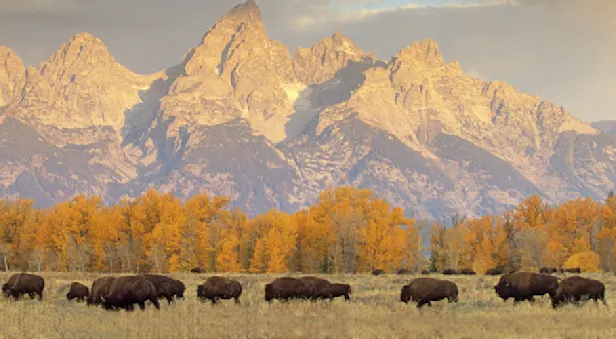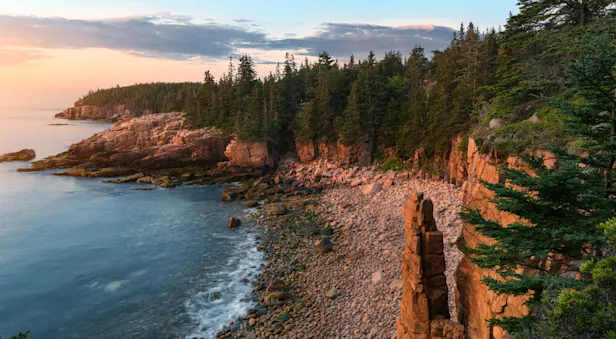Maine's Fall Foliage
Autumn in New England is a stunning spectacle. It is an extraordinary annual event that transforms everyday eastern woodlands into flamboyant forests that burst with crisp crimsons, over-the-top oranges, and brilliant yellows. Indeed, as attested by French philosopher and playwright Albert Camus, “Autumn is a second spring where every leaf is a flower.”
The annual eruption of fall color is one of nature’s greatest gifts. Walking into the kaleidoscopes of forests at this time of year is a full immersion into the season’s vibrant splendor. The air is cool and fresh, there is a pleasant earthy smell to the air and the forest floor feels soft under your feet. The experience as you explore, photograph, and reflect on the changing of seasons is nothing short of enchanting.
In many ways, fall’s resplendent colors are nature’s jubilant celebration of the past year. And, while this foliage phenomenon might seem as if it is fueled by magic, there is good reason why the forests experience a makeover each year. It is all part of a tree’s natural cycle before settling into winter’s dormancy. What follows is a scientific exploration of how and why fall colors occur, to complement what you’ll discover for yourself during your journey in New England.
FOOD FACTORIES
Tree leaves aren’t just for show. They are expressly designed to produce food for the entire tree. You’re likely familiar with the term photosynthesis, which is the process by which plants make their own food. It is an incredible undertaking that is wholly different from how you and I nourish ourselves. Photosynthesis requires three ingredients: water, carbon dioxide, and sunlight.
Water comes from the ground, collected by roots and transported by the tree’s interior plumbing to all its parts. Carbon dioxide comes from the atmosphere, absorbed by the leaves through tiny pores called stomates. Similarly, sunlight (the energy source that catalyzes this process) is collected by leaves via structures called chloroplasts. With each ingredient present, the chemical reactions of photosynthesis take place within the chloroplasts, whereby the tree produces food in the form of sugars and generates waste in the form of oxygen. Once the sugar is created, it is then transported throughout the rest of the tree as food in the form of sap.
Chances are you’ve eaten sweet tree sap yourself, in the form of maple syrup. Trees like the famous sugar maples found in northeastern forests have sap that we humans find especially delicious. Most trees, though, do not have their sap harvested. Surplus sugars are instead converted into starch and stored in a tree’s roots. They can then be reconverted to sugars at a later time, to fuel growth when photosynthetic production is lower than the current needs of the tree. For instance, starches will be converted back to sugary tree food when healing injuries from broken branches or when it’s time to grow new leaves from scratch in the springtime.
A crucial aspect of photosynthesis is that it can only take place when a tree’s leaves are at an optimal temperature. Each tree species is different, but for any tree there are temperatures that are too warm or too cold to photosynthesize. This scenario is common for us as humans too, and provides an illustrative analogy: Imagine a laborer working in the outdoors. Some summer days are just too hot to be productive, and most winter days are too cold. We often take a siesta or work indoors until outside conditions are more suitable.
For trees, hot summer temperatures are fleeting, and so photosynthesis is able to carry on in the earlier and later parts of the day. By autumn and throughout the winter, however, temperatures remain low and a tree leaf’s tissues are just too cold to photosynthesize at all. Since tree leaves exist specifically to photosynthesize, it doesn’t make much sense for the tree to continue allocating energetic resources to leaves that can no longer function properly. Additionally, winter’s freezing temperatures will severely damage leaves, rendering them useless no matter if it becomes warm outside or not. For both of these reasons, deciduous trees drop their leaves in the fall. They then regrow fresh leaves in springtime, once photosynthesis can again be performed.
AUTUMN’S ONSET
How do trees know when it’s time to drop their leaves? First, the “early warning system” kicks in. As the days get shorter, known as a “reduced photoperiod,” the trees begin to draw nutrients from the leaves back into the trunk and down to the roots. By the time of the next signal, plunging temperatures, the leaves are nearly ready to drop to prepare the tree for the long winter ahead.
The stage is set for changing colors, but why and how do the leaves actually change color? Upon considering why a tree’s leaves turn colors in the autumn, you might also find yourself curious as to why they are green in the first place. Or even if they are really green.
It has to do with how trees produce their own food. Within the photosynthetic chloroplasts is a green pigment called chlorophyll. During the spring and summer months, chlorophyll is constantly being consumed and replaced during photosynthetic chemical reactions. Chlorophyll is very abundant, so much so that it actually conceals other color pigments that are present in tree leaves, making the entire leaf appear green.
More precisely, chlorophyll masks yellow xanthophyll pigments and orange carotenoid pigments. With the onset of autumn, however, photosynthesis grinds to a halt, and therefore so does chlorophyll production. As all the remaining green chlorophyll breaks down, luminous yellows and oranges – which were present all along – are revealed. Think of this scenario like adjusting your wardrobe; you can remove your green jacket to expose an orange shirt beneath.
Red and purple leaves are a little different. As the remaining chlorophyll deteriorates in the fall, additional chemical processes take place in some trees that create red and purple flavonoid pigments called anthocyanins. Why tree leaves expend the energy to produce anthocyanins immediately prior to being cast from the tree is something of a mystery. The newest science points to benefits such as aiding in the prevention of pest and disease infestation during the tree’s seasonal transitionary period. Red and purple plant tissues can also better absorb sunlight in cooler temperatures versus green tissue. Warmer tissues likely allow leaves to more fully process and transport any remaining nutritional resources from leaf to tree prior to being severed from the branch. That is, some photosynthesis may still be able to occur in cooler temperatures, albeit at a reduced rate, thanks to the presence of anthocyanins.
“THE FALL”
Autumn’s final act sees our trees shedding their colorful leaves. With energetic resources within the leaf mostly consumed, the tree naturally severs the leaf, a process called abscission. Abscission is triggered when the tree cuts off the leaf’s water supply, which decisively stops photosynthesis and causes the leaf to perish. A dazzling natural carpet appears on the forest floor, through which winding trails lead you deeper into the vibrant realm of color.
NATURAL VARIATION
Like most natural phenomena, autumn colors are influenced by a variety of environmental factors. The timing, duration, and intensity of colors can differ from place to place and from year to year thanks to variable conditions. One of the biggest drivers of color is temperature. Weeks of consistently cool weather enhance colors (especially the reds and purples), while early frosts can kill off plant leaves prematurely.
Water also plays a key role. Plenty of available groundwater and occasional rains are beneficial, while summer drought can cause premature deterioration and death of leaves. Even the pH of the water is consequential, being one of the main drivers of intensity for red and purple hues.
Lastly, wind plays an important role, for the obvious reason that if it’s extremely windy then the leaves are prematurely stripped from the trees. Peak fall colors therefore do not occur at a precise time each year. Rather, specific stands of trees will each experience peak color at different times throughout the season, all dependent on recent weather patterns and local conditions.
In the bigger picture, leaf colors help to tell the story of individual trees or entire forest stands thanks to natural variation. While you are marveling at the multi-hued northeastern forests during your trip, notice how tree leaf color intensity varies from place to place. Take note of which trees are in their full glory, and which species are just getting going. Notice differences between hilltops and valleys, and from riverbank to upland forests. Consider what environmental conditions might have contributed to the vibrant scene you witness before you.
TRANSFORMING TREES
So far, we’ve discussed trees and fall colors as if every tree experiences an autumnal metamorphosis. In fact, only certain trees lose their leaves, as you’re likely already aware. Likewise, only some of those trees assume vibrant colors. It’s easy to discern which trees will produce color if you know just a little about them.
There are two main categories of trees: hardwoods and softwoods. Hardwoods are leaved trees that reproduce using flowers, fruit, or nuts. Softwoods are needled trees that reproduce using cones. Generally, hardwoods are deciduous, meaning they lose their leaves each autumn. The softwoods—commonly called conifers—are evergreen. But there are notable exceptions to this characterization because, well, nature is complex! Evergreen hardwoods exist (bay laurel and live oak, for example), as do deciduous conifers (like the eastern larch.)
During your trip, be on the lookout for the most colorful hardwoods, which including sugar maple, red maple, red oak, mountain ash, birch, black walnut, bitternut hickory, sycamore, and aspen. In some areas, you can also witness the brilliant golden needles of the coniferous eastern larch, also known as tamarack. Each of these tree species does autumn a little differently. Some will exhibit colors early, some late, and some throughout the season. Some trees have leaves that will always be one color (e.g., red sugar maple), while others may exhibit different colors, even on the same individual tree (e.g., the multi-hued sycamore). The time that colorful leaves will remain on the tree varies by species also. For instance, some trees shed the entirety of their colorful canopy in just two to three days (e.g., ash), while others retain leaves even into the wintertime, barring extreme wind events (e.g., oaks).
THE QUEST FOR BEAUTY
While knowing the science behind leaf color change might help you move one layer deeper in the humus of understanding how nature works, it is not necessary for appreciating the complex and colorful tapestry of a New England hillside in the fall. It is certainly not the reason why millions of people undertake a pilgrimage to the northeastern forests every year to have their souls refreshed by this explosion of nature’s beauty.
So, what is it? Why are so many of us drawn to this spectacle? Perhaps it has to do with seeing an entire forest go out in a blaze of glory, only to greet us again with fresh green buds after a long winter – an endless cycle of senescence and regeneration that reminds us that nature never ends. Maybe we have become so numb in our over-stimulated modern world that we have a deep need for moments that take our breath away. Maybe it’s just pretty, and that’s enough. There are probably as many reasons as there are leaves in the forest. While you are on this journey, we encourage you to spend some quiet moments contemplating why these trees have called you here.
See Fall Foliage on These National Park Trips

Hidden Yellowstone & Grand Teton Safari
A small-group exploration of Yellowstone and the Tetons as few get to experience these iconic parks—scout for wildlife and discover secret places with our naturalist guides who know this region intimately.
































